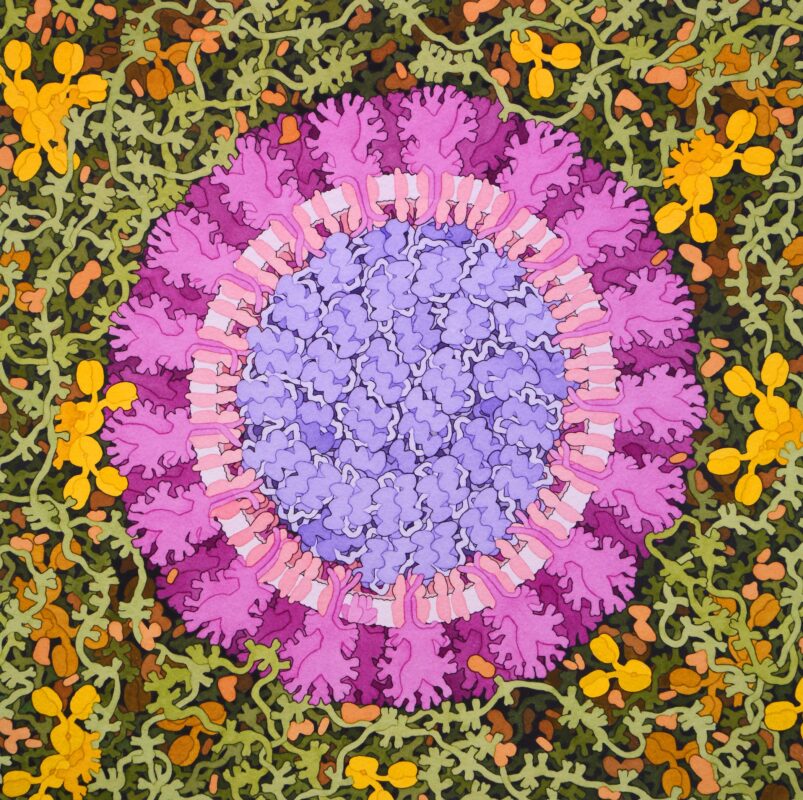The UK has identified a new variant of the coronavirus, SARS-CoV-2, that is spreading rapidly in the South Eastern part of the country. The emergence of new viral variants signals that the virus is changing in response to selective pressure, raising the stakes in the fight to control the pandemic. This new variant has multiple changes and deletions of protein sequence in its spike protein—that’s the piece that protrudes from the surface of the virus and grabs onto cells as it attacks them. The variant, known as SARS-CoV-2 VUI 202012/01 (Variant Under Investigation, year 2020, month 12, variant 01) was identified through a program of viral sequencing intended to monitor the evolution of the virus.
Modeling studies by the UK government predict that this variant is up to 70% more transmissible. Another unpublished preliminary study estimates 56% increased transmissibility. The virus seems to be associated with a recent dramatic rise in daily case counts in the UK. The proportion of cases caused by this variant is also increasing rapidly, and according to England’s Chief Medical Officer, it is rapidly becoming the dominant form of the virus. (via CNBC) At this time, the mutations in this variant are not believed to affect disease severity, and it is as yet unknown whether the variant will be less (or more) susceptible to vaccines and antibodies. The UK has responded with a new round of restrictions intended to suppress the spread of the variant, and 40 countries have banned travel to the UK. US FDA Commissioner Scott Gottlieb told CNBC that the new variant is likely already in the U.S. A small number of cases have been found in Denmark and the Netherlands and one case in Australia. Another mutant strain with changes similar to the UK variant has emerged independently in South Africa. This variant, as well, may have increased transmissibility, according to a preprrint at medRxiv. (Note: preprints are not yet peer-reviewed.)
The uncertainty around the significance of these individual mutants can not be overstated. There’s just no way to know yet how they may or may not change the course of the pandemic. However, in the bigger picture, they are a sign that the pandemic is entering a new phase where viral evolution is becoming more important. That’s according to Aris Katzourakis, a Professor of Evolution and Genomics at the University of Oxford. Katzourakis studies viral evolution. “We’re moving to a stage in the pandemic where enough time has passed, the evolutionary processes have had enough time to play out that they’re actually potentially going to impact the further course of the pandemic,” says Katzourakis. “It’s important to be very careful about what’s possible, what’s probable, and what’s impossible in this space, given that we are going to be seeing more potential stories of this nature.”
Speculation about the evolutionary path of the virus has become a vehicle for misinformation, especially beliefs that the virus will inevitably mutate to become less harmful. That is, indeed, theoretically possible, but Katzourakis says it is unlikely for SARS-CoV-2. Viruses mutate to become less harmful primarily when they are so deadly they kill their hosts before the hosts are able to spread the virus. In that case, evolutionary pressure will favor a less harmful variant that gives the host a chance to spread the virus to others. That’s not the case with SARS-CoV-2, a virus with a long incubation period and a large proportion of asymptomatic or mild cases.
Meanwhile, evolutionary pressures exerted on a virus could push it in the other direction—to a more dangerous form. Some of the conditions that could exert that pressure include competition with other viruses, widespread growth in the population, and transmission between humans and animals. Minks have been found to be good hosts for the virus, and mink farms have produced some SARS-CoV-2 variants of unknown significance.
Another unwanted left turn in viral evolution could happen as new vaccines are slowly rolled out worldwide. Katzourakis says this could allow for the development of an “escape mutant” of the virus that is resistant to the vaccine. In turn, that could require manufacturers to pursue those new variants with updates to their vaccines, similar to influenza vaccines which are updated every year with the latest strains.
“So far, we haven’t seen any signs of increased harm, and it’s not something we can rule out, but it’s not something we should overly concern ourselves with for the time being. Managing the harm that we know this virus is causing in the here and now is enough to keep us busy,” says Katzourakis.
Managing the harm by restricting the ability of the virus to spread is also the best way to head off those worst case scenarios for viral evolution. Katzourakis explains, “The more the virus is replicating itself, the more chances there are for things to go wrong. So if the evolution of the virus and the possibility it could get worse concern us—and I think it should concern us—then the best thing we can do is the same thing we’re doing to control the replication of the virus, which is to make sure the virus doesn’t spread.”
